|
Your online resource for all things culinary |
|
|||||||||
|
||||||||||
|
||||||||||
| Â | ||||||||||
|
||||||||||
How to make Potato Gnocchi and other Vegetable GnocchiThe potatoes (or other vegetables) must be fully cooked and mashed to a smooth consistency before adding the egg yolks and flour. As the aim is to get a light dough, the less flour which can be added, the better, so the vegetables should be as dry as possible once mashed. For this reason, many cooks advocate baking the vegetables,  however, with a little care, this isn�t absolutely necessary and boiling or steaming vegetables, particularly if cooked in their skins, should suffice. A great alternative is to microwave the vegetables as very little water needs to be added.  Mash the vegetables well with a fork or potato masher or, better still you can use a potato ricer which will ensure there are no large lumps and will give a lighter texture. Under no circumstances add any liquid or fat to the mashed vegetables.  Are eggs necessary?The quick answer is no. Although they have a limited binding and colouring effect, their addition was probably to add extra protein, especially when served with simple vegetable sauces, so if you don't want to use them don't. Do bear in mind you may need less flour to achieve the required dough consistency.  Which potatoes are best for making gnocchi?Choose floury potatoes as these contain less moisture and will mash and fluff up well. Good varieties of floury potatoes to use include Estima, King Edward, Maris Piper and Desiree.  Proportions and ratios of flour to potato or other vegetablesThe ratio of flour to vegetables used is important but can vary quite a lot depending on the wetness of the ingredients being used. In general the ratio is one third flour to vegetables. As a guide below are some general measures and serving sizes. Â
 It is important to note that the mashed vegetables whether potatoes or other, must be warm when you start to mix in the eggs (if using) and flour otherwise you may face problems handling the dough.  Once you have your warm mashed vegetables, you can start mixing the flour, vegetables, eggs and salt or other seasonings together either in a mixing bowl or on a floured work surface. Â
 At this point, if you prefer your gnocchi to be heavier or chewy, add more flour and knead the mixture briefly.    How to shape potato gnocchi and other vegetable gnocchiÂ
  As with pasta, it is easier to work with smaller pieces of dough, so divide the mixture into 3 or 4 portions (more if you have made a large batch). Roll each portion out to a long cylinder no larger than 2cm/ � � in diameter on a well floured work surface, then cut the roll into 2.5cm/1� lengths.  Â
  Although these cut pieces can be cooked as they are, it is a good idea to make ridges in each piece so that once cooked, they more easily trap the sauce with which they are served.  Â
  This is traditionally done by flattening each piece on the back of the tines of a fork, making sure you don�t go all the way through the dough, then fold over or roll the flattened piece with your thumb before dropping onto a lightly floured surface.    If you are not au fait with this technique, if can be a little trying until you get the knack, so if you are in a hurry, you can simply make a dimple with your knuckle in the centre of each piece which is a lot easier and quicker. The main point of the exercise is to create an indentation which will hold the sauce when eating.  Here are some tips for ridging gnocchi with a fork
Once you have finished forming the first portion of dough into individual gnocchi, toss gently in flour to give a very light dusting, transfer to a lightly floured tray, making sure the pieces are in a single layer and not piled on top of each other, then repeat with the remaining portions of dough.  You will find it easier to flour all the rolled pieces of one portion of dough at a time rather than dusting each individual piece separately, and once you�ve got the knack, you�ll be surprised how quickly you manage to cut, ridge, roll and dust.  Once formed, fresh gnocchi should be cooked as soon as possible to prevent them going sticky or gooey, so don't make them too far in advance.  How to cook potato gnocchi and other vegetable gnocchi Jump to:  How to cook semolina gnocchi  Whilst there are recipes for baked gnocchi, in most cases the gnocchi has to be boiled first. This is done in a similar way to cooking pasta.  It's best to use as wide a pan as you have to ensure the gnocchi have space to float around and cook evenly without sticking together. Although the pan's width is more important than depth, make sure you have a good 10cm/4-inches depth of cooking liquid. You can use water or stock for extra flavour. Bring to the boil, add plenty of salt, then add the gnocchi and stir gently, keeping the liquid at a rolling boil. Â
  When the gnocchi rises to the surface, cook for only a minute more. The
whole cooking time is usually only a few minutes and it's important not to
overcook them.      How to serve potato gnocchi and other vegetable gnocchi Gnocchi can be served hot or cold.  If serving cold, as soon as it has been cooked it needs to be cooled quite quickly. The best way is to transfer to a colander and place under cold running water for 1-2 minutes. Drain very very well, allow to cool a little then coat lightly with olive oil and refrigerate until ready to serve. Cold gnocchi can be used in a similar way to cold pasta.  When serving hot, once well drained, it should be served as soon as possible with the sauce of your choice. Alternatively, it can be used in baked recipes.  How to make Semolina GnocchiÂ
 However, the most popular method of using semolina gnocchi is to bake it. This uses a completely different method.  The semolina is added to boiling milk then cooked gently for around 8-10 minutes until thick. Seasoning, egg yolks and sometimes cheese and butter are then stirred into the mixture before it is turned out into a shallow tin and left to cool completely for around 2 hours until set.  Once set, the mixture is cut into circles, squares or triangles, and then baked in a shallow dish with or without a sauce.   Freezing Fresh GnocchiUncooked freshly made gnocchi freezes well so it's well worth making more than you need and freezing the excess.  To freeze homemade gnocchi, make and form the gnocchi as usual, then after dusting lightly with flour, place in a single layer on a flat tray, and open freeze until they start to get solid. This is important so that they don't all stick together and create one large dumpling.  Once they are frozen enough to be easily handled, transfer to labelled freezer bags. To use, always cook from frozen in the same way as above. The cooking time will only be a little longer.  Gnocchi RecipesAs mentioned above, creating your own gnocchi at home to suit your personal tastes is relatively simple once you�ve mastered the basics, so it�s best to try a couple of the recipes below before embarking on creating your own.  Click the link below for lots of gnocchi recipes to get you on your way including baked semolina gnocchi recipes, potato gnocchi recipes, pumpkin gnocchi recipes, sweet potato gnocchi recipes and lots more.  Click here for lots of Gnocchi Recipes |
||||||||||
Â
|
||||||||||
| Â | ||||||||||


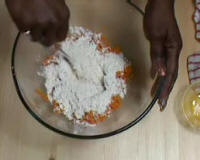 Make a well in the centre of the
vegetable mash, add the eggs which have been beaten and seasoned, then add
around � of
the flour and start mixing together. Mix as quickly and as lightly as you can
and try not to overwork the mixture as this will cause the gluten in the flour
to elongate creating a tough dough. Using a knife initially may help, then
continue to mix using your fingertips to gently pull the mixture together.Â
Only add enough
of the remaining flour to make a non-sticky dough which will hold its shape.
Make a well in the centre of the
vegetable mash, add the eggs which have been beaten and seasoned, then add
around � of
the flour and start mixing together. Mix as quickly and as lightly as you can
and try not to overwork the mixture as this will cause the gluten in the flour
to elongate creating a tough dough. Using a knife initially may help, then
continue to mix using your fingertips to gently pull the mixture together.Â
Only add enough
of the remaining flour to make a non-sticky dough which will hold its shape.
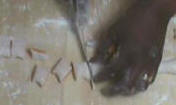
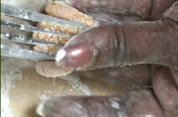
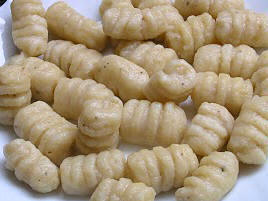
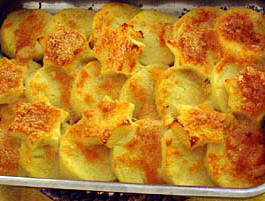 Making semolina gnocchi for
boiling is much the same as making vegetable gnocchi - mix egg yolks with salt
and enough semolina to form a stiff dough, form into shapes and boil.
Making semolina gnocchi for
boiling is much the same as making vegetable gnocchi - mix egg yolks with salt
and enough semolina to form a stiff dough, form into shapes and boil.